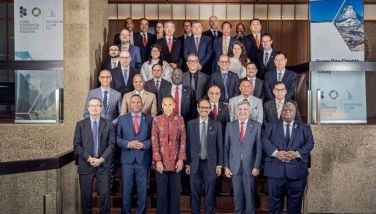At the Center of the artistic universe
 A monkey man flexes his muscles. A rabbit poses like a Playboy bunny. A rhinoceros plows toward an appointment with doom. An army of half-man/half-mutant creatures gets rolled over by a ball of flesh. Skulls, carcasses everywhere. A dog-man nurses a broken neck. Everything is beautiful.
A monkey man flexes his muscles. A rabbit poses like a Playboy bunny. A rhinoceros plows toward an appointment with doom. An army of half-man/half-mutant creatures gets rolled over by a ball of flesh. Skulls, carcasses everywhere. A dog-man nurses a broken neck. Everything is beautiful.
No, I haven’t dropped acid nor I am in Dante’s inner circle of hell. I am merely surrounded by the paintings and sculptures of Filipino contemporary artist Ronald Ventura as part of his “Zoomanities” exhibition currently on view not in a mausoleum-like museum but inside — would you believe — a mall. Heavens to murgatroid, as Snagglepuss would say. That’s the idiosyncratic thing about malling in the Philippines: you could be buying some mundane everyday prop like a can of milk, diapers or undergarments in one moment, and the next you’re looking at the awe-inspiring art of Ronald Ventura or Manuel Ocampo or Elmer Borlongan. Reminding us that there is more to life than looking for bargains and best buys.
This is the Art Center at the SM Megamall Art Walk; most of the artists we admire have broken new ground here — from conceptual art master Roberto Chabet to his disciples, from the Social Realists (Pablo Baens Santos, Antipas Delotavo and Renato Habulan) to the hyperrealists, from printmakers to performance artists. And the Art Walk has been pumping ironies, epiphanies and paradoxes as well as encouraging dialogues, encounters with and revaluation of the sublime since 1992.
Before that landmark year, shopping malls and art appreciation weren’t considered part of the same intellectual cocktail. No one, at least in our country, thought it could make a good mix. Like peanut butter and broccoli with vodka tonic, perhaps. To view the latest exhibitions, my Malabon friends and I would take the jeepney to Hiraya Gallery or the bus to West Gallery and Finale Art File, which for us was like journeying from Saturn to Uranus. The only place at that time that had row after row of galleries was Mabini. And we weren’t too keen on seeing paintings of boats, fishermen, fields, farmers and other subjects in impasto universes. Maybe after a few beers and Metallica or Bonnie Tyler songs by an all-girl band at Calle Cinco.
When SM Megamall first opened, Hans Sy, SM Prime Holdings president, thought of mounting a show for Sanso, a close friend of his dad, Henry. The show was held in a then-vacant space in Building B of the mall.
“Hans loves art,” says Vita Sarenas of Finale Art File says. “He regularly went to Finale to unwind when it was still at Sunvar Plaza.”
Vita worked with Millie Dizon, now currently SM marketing communications group VP, on the inaugural show at Megamall. The Sanso exhibit titled “Bulaklak: A Flower Retrospection” was so successful (the paintings, oil on canvas and acrylic on paper, were bought not just by art collectors, but also by people who just happened to pass by) that Hans thought of devoting a whole mall floor to Filipino art. A row of galleries, an “art walk” if you will. Now, that would work.
Vita explains, “We suggested that the row of galleries (the same in the art-walks in the US and in Europe) would have (simultaneous) exhibit openings once or twice a month. Then people would just walk by the galleries and see contemporary art up close.”
The pioneering galleries were Finale Art File, West Gallery, Heritage Art Center, Gallery Genesis, Liongoren Art Gallery, Galleria Duemila, Pacheco Art Gallery and Contreras Sculptures. Other galleries followed — Gallery Y, Nemiranda Arthouse, Gallery of Prints, Gallery 139, and The Crucible Gallery (which still is the turf of masters such as Cesar Legaspi, Arturo Luz, Bencab, Malang, Onib Olmedo, Pandy Aviado, and Romulo Olazo, among others). What’s interesting to note is that many of the galleries were run by artists themselves — like Malang, son Soler Santos and his wife Mona Santos who manage West, and Norma Liongoren — and art aficionados such as Silvana Diaz and Chichi Salas.
Thus, the fourth floor of SM Megamall A became a hub for art of all variants: from the conventional to the avant-garde. Mallers passing by would see a painting of something rural and idyllic in one moment (the dappled sunlight, the mighty bushes); and in the next, a space inhabited by objects that redefine “what art is and what should never art be.” Dazing and confusing, yet art just the same. The joint was a-rockin’.
Millie explains, “The SM Art Walk has given diversity to malling, offering more than shopping to mall-goers. It underscores how important art is in the lives of Filipinos from all walks of life. Because of this, more and more people appreciate art more. The SM Art Walk has democratized art in the Philippines. Everyone can now appreciate art. It has made art more accessible to all Filipinos.”
Vita agrees. “I am so grateful to Hans for putting up the Art Walk. He’s our patron. He’s very supportive of what we’re doing.”
Walk of Life
Lots of memorable exhibits have been mounted at the SM Art Center. Like the Chabet-curated “True Confessions” exhibit in 2000 that featured young artists, or Wire Tuazon’s “Reality Sandwiches” in 2007, or the “3Anggulo” exhibit in that same year curated by Jose Tence Ruiz.
One of the most far-out is Manuel Ocampo’s 2005 show billed as “Mumu Territorium: Jabar Logic in Times of McArthurian Transgressions Multiplying on the Borders of the Concatenated post-Duchampian Theatre Swastikating between Love and Hate.”
Ocampo is one of the most important artists alive today. He’s a Filipino artist who has impressed critics and collectors in Europe and the States, mounting one-man shows in galleries such as La Luz de Jesus in LA and Annina Nosei in New York, among others (American artists like Liz McGrath and Camille Rose Garcia even cite Ocampo as an influence). He also participated in group shows with the likes of Jean Michel-Basquiat in Seattle and Don Ed Hardy in New York. His paintings are part of the collection of the Museum of Contemporary Art in LA, the Saatchi Gallery in London, Galeria OMR in Mexico, and Museo de Bellas Artes de Bilbao, etc. (Who among the chi-chi artists favored by high-society limo-wrecks can brag about these things in their CVs?)
MJO is a Filipino who has made his mark in the international art world. A case of the “colonized” doing a reverse-colonization of sorts. And Ocampo has done so by painting Klux-Klux Klansmen bearing crosses and swastikas, Jesus with wings and talons, rat junkies, Humpty-Dumpty clutching a rosary, World Babies and Cockroach Deities — all marching in a parade of postcolonial pathology. Everything is beautiful.
We want more of those in the Art Walk. More of Ocampo, Ventura and former members of Saligpusa. More of Geraldine Javier, Louie Cordero, Jayson Oliveria, Robert Langenegger, Romeo Lee, Nona Garcia, Lena Cobangbang, Annie Cabigting, Mariano Ching, Yasmin Sison, and Wire Tuazon to dazzle us with their hallucinogenic visions. More of the masters such as Malang, Bencab, Luz and Olazo to awe us with outstanding technique. More of the happenings instigated by Gus Albor, Vim Nadera, Pinikpikan, and the Tupada artists. More of youngsters such as Lynyrd Paras, Froilan Calayag, Jason Montinola, Demosthenes Campos, Ryan Rubio and the Samsons to prove to other youngsters that it can be done.
Heck, even an insignificant artist like me is given the opportunity to mount an exhibit at the Art Walk because art is for everyone, and there’s a place for every kind — from calming flowers on canvas to disturbing skulls on vinyl.
(A digression: When I mounted my first show at The Crucible in 2006, I was a walking bag of flesh, hair and frayed nerves. My paintings were all about emaciated rock ‘n’ roll figures like KISS and Zappa with exposed innards — heavily textured and so badly drawn. I couldn’t paint flowers for jack shit, even if you threatened me with a rusty castrating device. While The Crucible gave me a chance to exhibit my quirky works, SM executives Hans and Millie were very supportive. A lot of people stopped by the gallery; even a 10-year-old kid wanted a skull painting. It encouraged me to paint even more. For better or for worse. And I’ve always thought that the only painting I will be involved in was retouching tombs in the North Cemetery or applying makeup to corpses. Come to think of it, there is not much difference in what I paint now.)
Where Do We Go Now?
There will be changes in the SM Art Walk for sure. Galleries will go, other galleries will take over. Maybe less of the cutting-edge iconoclastic oeuvres; maybe more of the decorative non-confrontational kind. Maybe this, or maybe that. Like a lot of things in Philippine art, we can never tell. So, we have no choice but, as David Bowie sings, to turn and face the strange changes. But surely that doesn’t mean we have to turn away from the original vision.
“As gallerists we are not just here to make a living, but also to educate people on art, to nurture their tastes,” Vita concludes. “Most of all we have to take care of the artists. Without them, we have nothing.”
* * *
Special thanks to Finale Art File, West Gallery and The Crucible for the additional photos. For comments, e-mail iganja_ys@ yahoo.com.
















